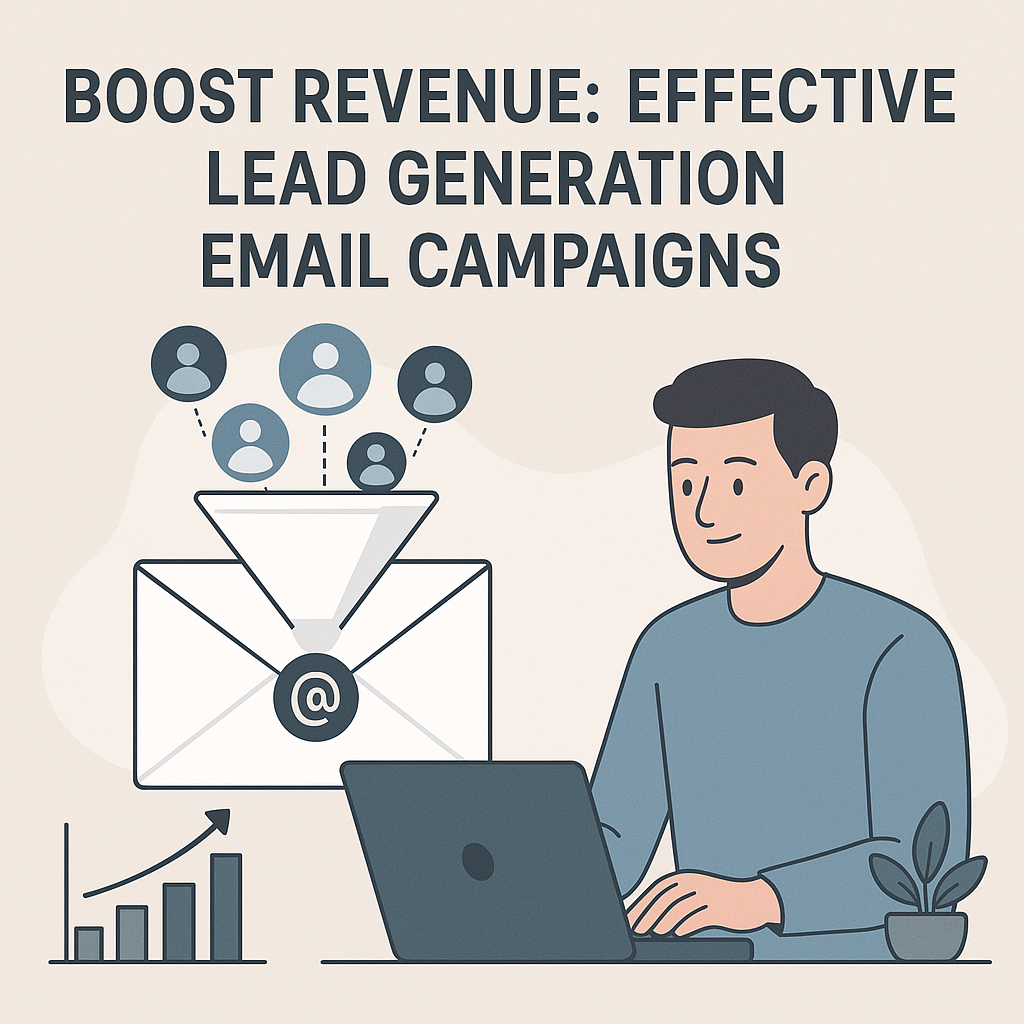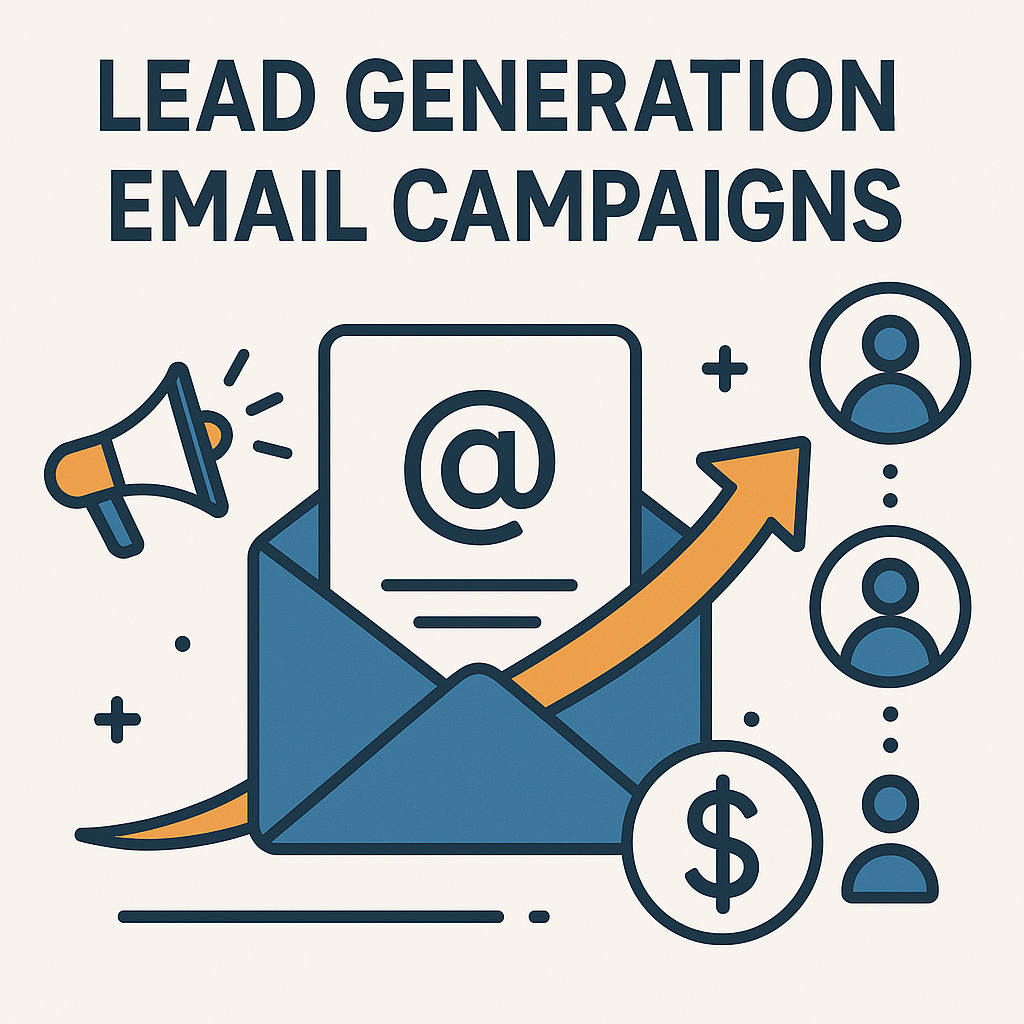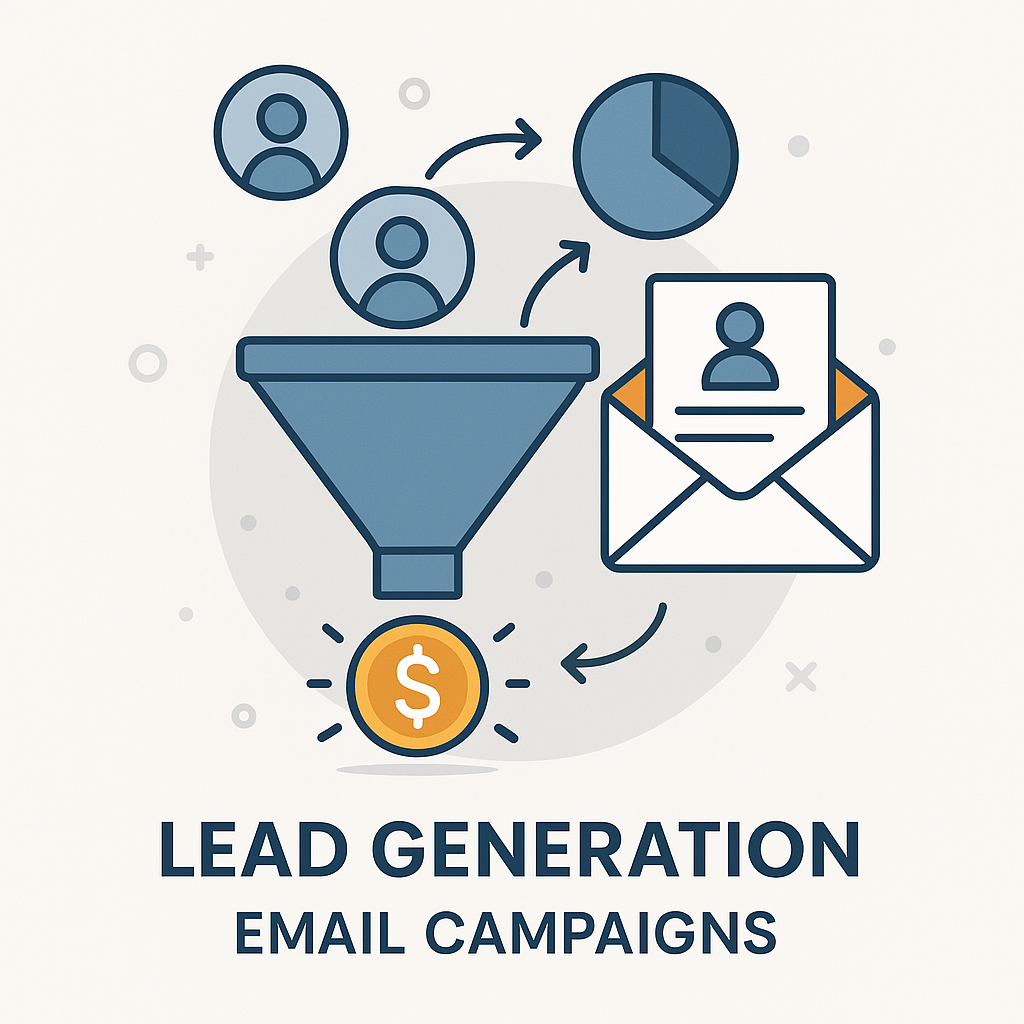Boost Revenue: Effective Lead Generation Email Campaigns

In the relentless pursuit of business growth, acquiring new customers is paramount. But how do you consistently turn interested prospects into paying clients without breaking the bank or drowning in manual tasks? For many sales and marketing professionals, entrepreneurs, and busy executives, the answer lies in the strategic power of lead generation email campaigns. Yet, the reality is often a struggle: emails go unread, personalization feels forced, and the hoped-for revenue boost remains elusive. This comprehensive guide is designed to equip you with the knowledge and actionable strategies to create email campaigns that don't just reach inboxes, but resonate with audiences, drive engagement, and ultimately, boost your bottom line.
We'll delve into the art and science of crafting emails that capture attention, build relationships, and guide potential customers through the sales funnel. From mastering subject lines to leveraging the transformative power of AI, you'll discover how to optimize your efforts for maximum impact. Let's unlock the potential of your email marketing to fuel sustainable growth and achieve your revenue goals.
Understanding the Foundation of Lead Generation Emails
At its core, a lead generation email campaign is a carefully planned series of communications designed to attract and convert potential customers (leads) into valuable prospects for your business. Unlike one-off promotional blasts, these campaigns are strategic, focusing on building a relationship and guiding the recipient through a journey. The ultimate goal is to move a prospect from initial awareness of your brand or solution to a point where they are ready to engage further, whether that's requesting a demo, downloading a resource, or making a purchase. This process is fundamental to customer acquisition via email, transforming passive interest into active engagement.
Think of it as a conversation starter. You're not just sending an email; you're initiating a dialogue designed to understand the prospect's needs and demonstrate how you can meet them. Effective lead generation emails are built on a foundation of understanding your target audience, identifying their pain points, and offering solutions that resonate. According to experts, email marketing remains one of the most effective B2B lead generation strategies, provided it's executed strategically and with a clear understanding of the audience's needs and preferences. The key is to be valuable, relevant, and consistently present without being intrusive. Businesses are always looking for ways to grow their user base, and lead generation plays a key role in making that happen by turning interest into action.
The journey often begins with an opt-in, where a potential lead willingly provides their contact information in exchange for something of value, like a free guide, a webinar registration, or a special offer. From there, a well-structured campaign nurtures this initial interest, providing further value and building trust over time. This approach is far more effective than a cold outreach strategy, as it starts with a foundation of mutual interest.
Crafting Compelling Subject Lines That Get Opened
Your subject line is the gatekeeper to your email's content. In a crowded inbox, it needs to be exceptional to stand out. A compelling subject line is the first impression, and it determines whether your email is opened or sent straight to the trash. The goal is to pique curiosity, convey value, or create a sense of urgency without being misleading or spammy.
Here are key strategies for crafting subject lines that get noticed:
- Personalization: Including the recipient's name or referencing their specific interests can significantly boost open rates. For example, "John, a special offer just for you" is more enticing than a generic greeting.
- Clarity and Conciseness: Get straight to the point. Recipients should understand the email's core benefit at a glance. Aim for 50 characters or less, as many email clients truncate longer subject lines.
- Create Curiosity: Pose a question or hint at a solution to a problem your audience faces. "Are you making these common sales mistakes?" or "The secret to boosting your productivity..."
- Highlight Value: Clearly state what the recipient will gain. "Free Guide: 10 Ways to Improve Your Website Traffic" or "Exclusive Discount Inside."
- Urgency/Scarcity: When appropriate, use time-sensitive language. "Last Chance: 24 Hours Left for 50% Off" or "Limited Spots Available for Our Upcoming Webinar."
- Avoid Spam Triggers: Steer clear of excessive capitalization, exclamation points, and common spam words like "free money," "guaranteed," or "win."
A/B testing your subject lines is crucial. Experiment with different approaches to see what resonates best with your specific audience. For inspiration, exploring examples of successful marketing email campaigns can provide valuable insights into what captures attention.
Personalization and Segmentation Strategies for Higher Engagement
Generic email blasts are a relic of the past. Today's savvy consumers expect relevant, personalized communication. This is where email personalization and strategic segmentation become indispensable for effective lead generation email campaigns. By understanding and catering to the unique needs and preferences of your audience segments, you can dramatically increase engagement and conversion rates.
Segmentation: Dividing Your Audience for Targeted Communication
Segmentation involves dividing your email list into smaller, more manageable groups based on shared characteristics. This allows you to send highly relevant messages to each group. Common segmentation criteria include:
- Demographics: Age, location, job title, industry.
- Behavioral Data: Past purchases, website activity (pages visited, content downloaded), email engagement (opens, clicks), stage in the sales funnel.
- Interests: Topics they've shown interest in, products they've browsed.
- Acquisition Source: How they joined your list (e.g., webinar, e-book download, contact form).
For instance, a prospect who downloaded an e-book on "Advanced SEO Techniques" should receive different follow-up emails than someone who signed up for a free trial of your project management software. The former might receive content related to SEO best practices and case studies, while the latter might get onboarding tips and feature highlights. This strategic approach ensures that your communication is always relevant, significantly improving the chances of conversion.
Personalization: Tailoring the Message
Once you've segmented your audience, you can personalize your emails. This goes beyond just using the recipient's name. It involves:
- Dynamic Content: Showing different content blocks within the same email based on the recipient's segment.
- Tailored Offers: Presenting promotions or solutions relevant to their specific needs or past interactions.
- Personalized Recommendations: Suggesting products or content based on their browsing or purchase history.
- Contextual Relevance: Referencing their recent activity, such as a recent demo request or a support ticket.
By implementing robust segmentation and personalization strategies, you can transform your lead nurturing efforts, making each communication feel like a one-to-one conversation. This builds trust, demonstrates understanding, and significantly improves the chances of conversion.
Writing Email Copy That Converts Leads into Customers
Once your subject line has done its job, the body of your email must deliver on the promise. Effective email copy for lead generation is about more than just sounding good; it's about persuading the reader to take the next desired action. This involves clear, concise writing that focuses on benefits and addresses the recipient's needs directly. It's a critical component of successful sales email best practices.
Here’s how to craft copy that converts:
- Focus on Benefits, Not Just Features: Instead of listing what your product or service *does*, explain what it *does for the customer*. For example, instead of "Our software has a cloud-sync feature," try "Access your files from anywhere, anytime, ensuring seamless collaboration and peace of mind."
- Speak Directly to Their Pain Points: Show that you understand their challenges. Start by acknowledging a problem they might be experiencing and then introduce your solution as the answer.
- Keep it Scannable: Use short paragraphs, bullet points, and bold text to highlight key information. Most people skim emails, so make it easy for them to grasp the main message quickly.
- Maintain a Consistent Tone: Your email's tone should align with your brand voice and resonate with your target audience. Whether it's formal, casual, or informative, consistency builds recognition and trust.
- Build Trust and Credibility: Include social proof, testimonials, or data points that support your claims. Mentioning industry recognition or awards can also add weight.
- Be Authentic: Avoid jargon and overly salesy language. Write like a helpful advisor rather than a pushy salesperson.
Remember, the goal is to guide the reader towards a specific action. Each sentence should serve a purpose, moving them closer to the desired outcome. By focusing on value, clarity, and the recipient's perspective, you can write email copy that effectively converts leads.
Designing Effective Calls to Action (CTAs)
A lead generation email campaign is only as effective as the action it inspires. Your Call to Action (CTA) is the critical element that guides the recipient on what to do next. A well-designed CTA is clear, concise, compelling, and easy to find, ensuring that your carefully crafted message translates into tangible results.
Here’s how to design CTAs that drive action:
- Be Clear and Specific: Vague CTAs like "Click Here" are less effective than specific ones. Use action-oriented language that tells the user exactly what will happen. Examples include: "Download Your Free E-book," "Request a Personalized Demo," "Start Your 14-Day Free Trial," or "Learn More About Our Services."
- Use Action Verbs: Start your CTA with a strong verb that prompts immediate action. Words like "Get," "Download," "Register," "Claim," "Discover," or "Start" are highly effective.
- Create a Sense of Urgency or Value: If applicable, incorporate elements that encourage immediate action. Phrases like "Claim Your Discount Now," "Limited Spots Available," or "Get Instant Access" can boost conversion rates.
- Make Them Visually Prominent: CTAs should stand out from the rest of the email copy. Use contrasting button colors, ample white space around the CTA, and clear, legible fonts. Buttons are generally more effective than text links for primary CTAs.
- Place Strategically: While a primary CTA should be prominent, consider including secondary CTAs if relevant. Often, a CTA is placed after the main body copy, but sometimes including one "above the fold" or within the content can capture attention early.
- Keep Them Concise: Like subject lines, CTAs should be short and to the point. A few well-chosen words are usually sufficient.
Testing different CTA designs, placements, and wording is essential for optimizing your lead generation email campaigns. A strong CTA transforms passive readers into active participants, moving them further down the sales funnel.
Automating and Optimizing Email Campaigns with AI Tools
The complexity and volume of modern lead generation email campaigns can be overwhelming. This is where Artificial Intelligence (AI) and automation tools become game-changers, enabling businesses to scale their efforts, enhance personalization, and achieve greater efficiency. Leveraging AI in email marketing can significantly improve email campaign optimization and overall email productivity for sales.
AI can assist in numerous ways:
- Advanced Personalization: AI algorithms can analyze vast amounts of customer data to create highly personalized content, subject lines, and send times for individual recipients, far beyond what manual segmentation can achieve.
- Automated Workflows: AI can manage complex drip campaigns, trigger emails based on specific user actions (like abandoning a cart or visiting a pricing page), and automate follow-ups, ensuring no lead falls through the cracks.
- Predictive Analytics: Some AI tools can predict which leads are most likely to convert or identify the best times to send emails for maximum engagement, allowing for smarter resource allocation.
- A/B Testing Optimization: AI can automate and optimize A/B testing for subject lines, content, and CTAs, learning from results to continuously improve campaign performance.
- Content Generation Assistance: AI tools can help draft email copy, suggest subject lines, and even generate personalized content snippets, saving valuable time for marketing teams.
In today's fast-paced digital landscape, managing these intricate campaigns efficiently is paramount. Tools like an ai executive assistant can revolutionize your workflow, offering advanced capabilities to organize, automate, and analyze your email communications, freeing up valuable time for strategic thinking and execution. By integrating such tools, you can ensure your email marketing strategies are not only effective but also highly efficient.
For instance, understanding how to manage your inbox effectively is crucial when dealing with the increased volume of automated communications and prospect interactions. AI-powered solutions can help in this regard, as discussed in articles on how email AI transforms productivity. Furthermore, exploring the capabilities of AI within everyday tools, like those found in articles discussing ChatGPT for Gmail, highlights the potential for integrating AI assistance directly into your workflow. These advancements in AI assistant tools are making email management more streamlined than ever.
By embracing AI and automation, you can streamline processes, gain deeper insights into campaign performance, and ultimately, drive better results from your lead generation email campaigns.
Measuring Success: Key Metrics for Lead Generation Emails
To truly master lead generation email campaigns, you must understand what's working and what isn't. Measuring the success of your efforts through key performance indicators (KPIs) is essential for continuous improvement and demonstrating ROI. Without tracking, you're essentially flying blind.
Here are the critical metrics to monitor:
- Open Rate: The percentage of recipients who opened your email. A higher open rate indicates that your subject lines and sender recognition are effective.
- Click-Through Rate (CTR): The percentage of recipients who clicked on one or more links within your email after opening it. This metric shows how engaging your email content and CTAs are.
- Conversion Rate: The percentage of recipients who completed a desired action (e.g., filled out a form, made a purchase) after clicking through from your email. This is a direct measure of your campaign's effectiveness in generating leads or sales.
- Bounce Rate: The percentage of emails that couldn't be delivered. A high bounce rate (especially hard bounces) can harm your sender reputation and indicates issues with your email list quality.
- Unsubscribe Rate: The percentage of recipients who opted out of your email list. While some unsubscribes are normal, a high rate suggests your content may not be relevant or you're emailing too frequently.
- Return on Investment (ROI): The profit generated from your email campaign relative to its cost. This is the ultimate measure of success for any marketing initiative.
Regularly analyzing these metrics allows you to identify trends, pinpoint areas for improvement, and refine your email marketing strategies. For example, if your open rates are high but your CTR is low, it suggests your subject line is good, but the email content or CTA needs work. Conversely, a low open rate points to issues with your subject line or list health. By focusing on data-driven insights, you can continuously optimize your email campaign optimization efforts and ensure your lead generation email campaigns are consistently driving business growth.
Nurturing Leads and Building Long-Term Relationships
The journey doesn't end with a single email or even a single conversion. Effective lead nurturing is the ongoing process of building relationships with potential customers who are not yet ready to buy. It involves providing consistent value, demonstrating expertise, and staying top-of-mind, ensuring that when they *are* ready, you are their preferred choice.
Lead nurturing email campaigns are crucial for several reasons:
- Converts Cold Leads: Many leads aren't ready to purchase immediately. Nurturing campaigns educate them, build trust, and guide them through the buyer's journey.
- Increases Customer Lifetime Value (CLTV): By fostering relationships, you not only acquire customers but also retain them, leading to repeat business and higher CLTV.
- Establishes Authority: Regularly sharing valuable content positions your brand as a thought leader and a trusted resource in your industry.
- Improves Sales Efficiency: Nurtured leads are often more qualified and easier to close, meaning your sales team can focus on prospects who are genuinely interested and ready.
Strategies for effective lead nurturing include:
- Drip Campaigns: Automated sequences of emails sent at specific intervals, often triggered by a lead's initial action (e.g., downloading a resource). These can cover a range of topics, from product benefits to customer success stories.
- Content Marketing: Sharing blog posts, case studies, whitepapers, webinars, and tutorials that address the prospect's challenges and interests.
- Personalized Follow-ups: Beyond automated sequences, personalized emails based on specific interactions or expressed needs can be highly impactful.
- Segmentation for Nurturing: Tailor your nurturing content to specific segments based on their behavior, interests, and stage in the buyer's journey.
- Re-engagement Campaigns: For leads that have gone quiet, targeted campaigns can re-ignite interest.
Building long-term relationships through consistent, valuable communication is key to sustainable growth and maximizing customer acquisition via email. It transforms a transactional approach into a relational one, fostering loyalty and advocacy.
Conclusion: Your Path to Revenue Growth Through Email
Mastering lead generation email campaigns is not just about sending emails; it's about building relationships, providing value, and strategically guiding prospects towards becoming loyal customers. By focusing on compelling subject lines, deep personalization and segmentation, persuasive copy, and clear calls to action, you lay the groundwork for success.
Furthermore, embracing technology, particularly AI and automation tools, can revolutionize your efficiency and effectiveness. These tools empower you to scale your efforts, gain deeper insights, and optimize every aspect of your campaigns, from content creation to performance analysis. Remember the importance of continuous measurement and refinement based on key metrics to ensure your strategies evolve and improve.
Ultimately, your email marketing strategies should be a dynamic, data-driven process focused on nurturing leads and fostering long-term customer relationships. Start implementing these practices today to transform your email outreach from a routine task into a powerful revenue-generating engine for your business.



